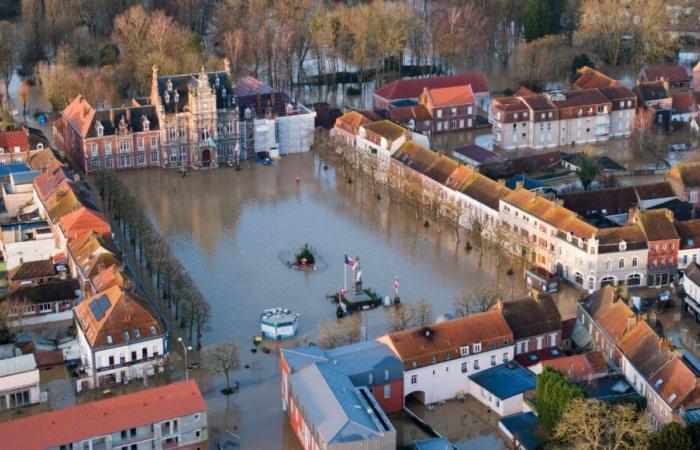In Pas-de-Calais, 315 communes of the 890 in the department were recognized as natural disasters following the successive episodes of rain which took place between November 2023 and January 2024. The accumulation of rain was unprecedented. The residents suffered 1.5 times a hundred-year floodnever seen before. The precipitation caused the overflow of the Aa, the Canche, the Hem, the Lys and the Liane, these coastal rivers which flow into the Channel. Floods, but also runoff and rising water tables, were observed.
On a more or less large scale, these floods affected 540,000 people. Hundreds of residents were evacuated and thousands of buildings were affected. According to the count established by the Pas-de-Calais prefecture dated October 7, 2024, the State has released 262 million euros to help Pas-de-Calais and the Northincluding the repurchase of houses, rehousing and numerous works.
A disaster in two waves
A first wave early November saw coastal rivers overflow, leaving entire villages devastated, with images that strike the mind. A week later, the rain fell again. One month latersome residents, had not yet returned home. During this first series of floods, 371 municipalities in Nord and Pas-de-Calais have been recognized as being in a state of natural disaster.
At the beginning of January, when the mud had barely dried, the rain fell again and the rivers overflowed again, rising in places up to 1.10m. HAS Arques, Water entered homes and businesses. HAS The Calotterie90% of the 700 inhabitants had to be evacuated. HAS Blendecquessome of the residents had to resolve to leave their homes permanently.
Nearly 900 people relocated
According to the results of the Pas-de-Calais prefecture, 889 people had to be rehoused, with relatives, in rental accommodation, or even in the village of bungalows located in Longuenesse that the last families have just left.
The State is committed to buy back houses that have become uninhabitable or on dangerous sites, most of them in Blendecques and Arques. There were 101 applications filed. As of October 30, 67 files have been validated, 19 under investigation. These homes will be razed and replaced by retention basins or grassy areas, in order to slow down further rising water levels. This program amounts to 10 million for the State.
Ameer Alhalbi
Between the damage to homes and businesses, floods cost insurance companies more than 462 million euros. But many victims took months to obtain their compensation, to the point that the government and the president of the Hauts-de-France region put pressure on insurance companies. Xavier Bertrand even went so far as to publicly name companies deemed too slow. If today, 92% of the assessments have been carried out, some of the victims are still waiting or are just starting their work.
The listening cell launched at the time of the crisis is still active and has expanded to “all questions relating to the consequences of flooding”. Agents can answer questions on rehousing, the acquisition of damaged houses by the State, or the installation of cofferdams, by calling Monday to Friday 03 21 21 23 40.
Thousands of projects in progress
A first series of emergency works was launched. No less than 3,000 road and public building rehabilitation projectssuch as educational establishments. At the same time, more than 600 projects were carried out on the waterways, in order to consolidate the dikes and banks, clean out the canals and remove obstacles.
Since spring 2024, 173 more structuring projects have been identified, to reduce the consequences of flooding as much as possible. This involves, for example, the cleaning of the Haut-Pont canal in Saint-Omer, the desilting of the Dordonne in the Brexent marsh or the strengthening of the Hesdigneul-lès-Boulogne basins. These longer works have not yet started for more than half. And all these projects put together are very expensive: 139 million euros were released by state services.
On the map below, we see the work in progress :
- in dark green, the work completed
- in light green, work started
- in dark blue, a service provider has been recruited
- in light blue, the construction site is scheduled
- in yellow, the site is currently being designed
- in gray, the progress is not known

Prefecture of Pas-de-Calais
Pas-de-Calais, a laboratory for adaptation to climate change?
If the causes of the disaster are multiple, such as the urbanization of flood-prone areas, or even the installation in the major river beds, the evolution of land use and agricultural practices, the solutions are complex. Since then, work has been undertaken to repair the damage, but also to try to develop the areas. A IGEDD interministerial mission was formed to work on the different tracks. Compensation procedures remain long and complex.
To improve prevention, the State is talking about establishing new management of waterwayswith a more readable, simpler organization. Beyond that, a consultation phase to understand the phenomenon of last winter and analyze its results has been launched. It will then be a matter of developing a roadmap. Pas-de-Calais would become an “experimental territory for the national plan for adaptation to climate change.”
loading








